Attached files
| file | filename |
|---|---|
| EX-99.1 - EX-99.1 - Laredo Petroleum, Inc. | a5921laredopetroleumannoun.htm |
| 8-K - 8-K - Laredo Petroleum, Inc. | lpi-20210507.htm |
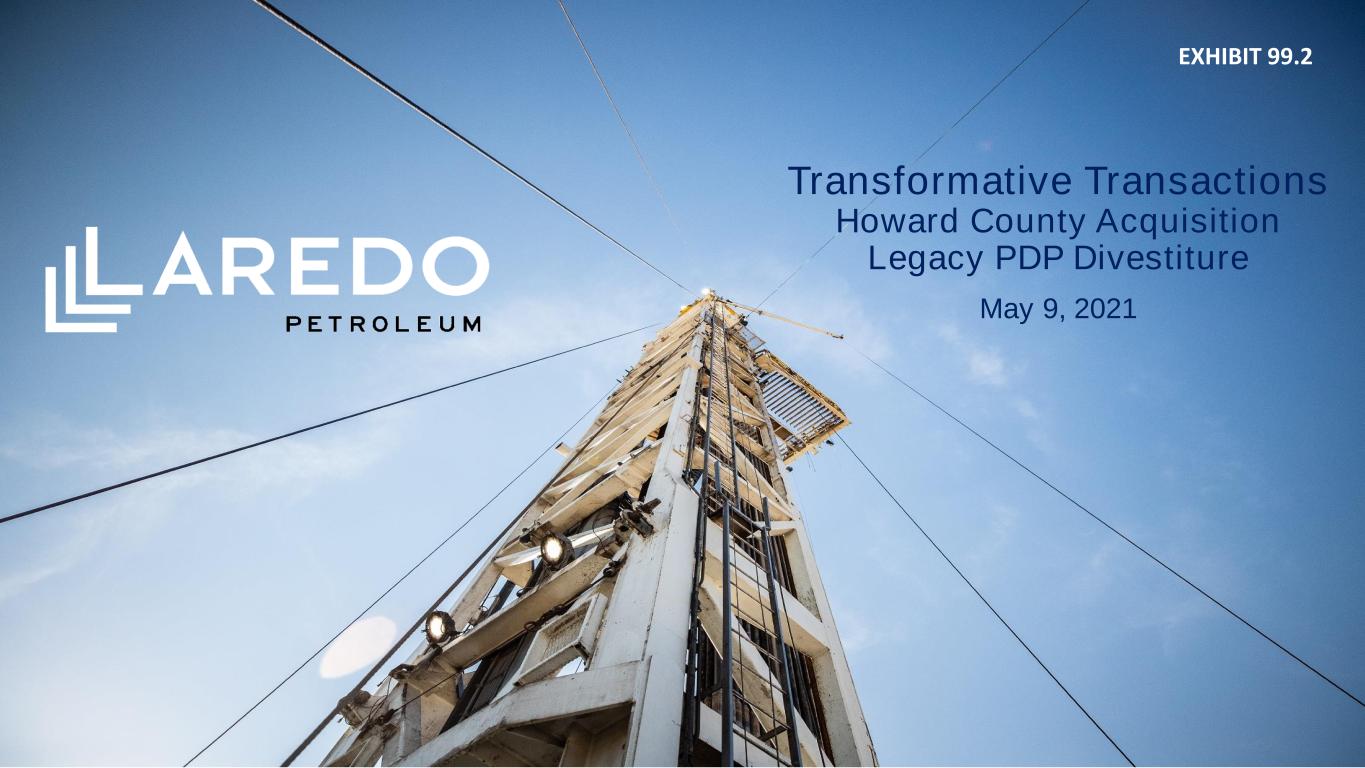
Transformative Transactions Howard County Acquisition Legacy PDP Divestiture May 9, 2021 EXHIBIT 99.2
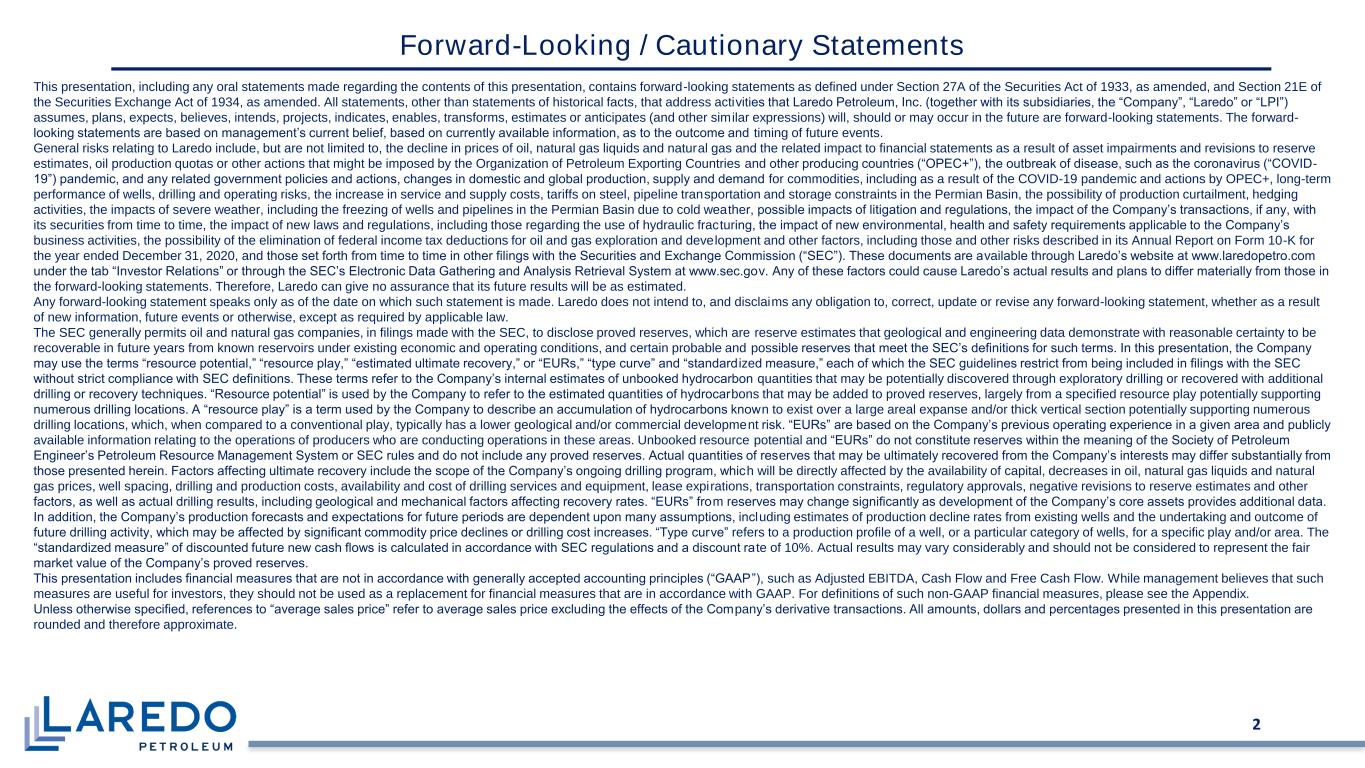
Forward-Looking / Cautionary Statements This presentation, including any oral statements made regarding the contents of this presentation, contains forward-looking statements as defined under Section 27A of the Securities Act of 1933, as amended, and Section 21E of the Securities Exchange Act of 1934, as amended. All statements, other than statements of historical facts, that address activities that Laredo Petroleum, Inc. (together with its subsidiaries, the “Company”, “Laredo” or “LPI”) assumes, plans, expects, believes, intends, projects, indicates, enables, transforms, estimates or anticipates (and other similar expressions) will, should or may occur in the future are forward-looking statements. The forward- looking statements are based on management’s current belief, based on currently available information, as to the outcome and timing of future events. General risks relating to Laredo include, but are not limited to, the decline in prices of oil, natural gas liquids and natural gas and the related impact to financial statements as a result of asset impairments and revisions to reserve estimates, oil production quotas or other actions that might be imposed by the Organization of Petroleum Exporting Countries and other producing countries (“OPEC+”), the outbreak of disease, such as the coronavirus (“COVID- 19”) pandemic, and any related government policies and actions, changes in domestic and global production, supply and demand for commodities, including as a result of the COVID-19 pandemic and actions by OPEC+, long-term performance of wells, drilling and operating risks, the increase in service and supply costs, tariffs on steel, pipeline transportation and storage constraints in the Permian Basin, the possibility of production curtailment, hedging activities, the impacts of severe weather, including the freezing of wells and pipelines in the Permian Basin due to cold weather, possible impacts of litigation and regulations, the impact of the Company’s transactions, if any, with its securities from time to time, the impact of new laws and regulations, including those regarding the use of hydraulic fracturing, the impact of new environmental, health and safety requirements applicable to the Company’s business activities, the possibility of the elimination of federal income tax deductions for oil and gas exploration and development and other factors, including those and other risks described in its Annual Report on Form 10-K for the year ended December 31, 2020, and those set forth from time to time in other filings with the Securities and Exchange Commission (“SEC”). These documents are available through Laredo’s website at www.laredopetro.com under the tab “Investor Relations” or through the SEC’s Electronic Data Gathering and Analysis Retrieval System at www.sec.gov. Any of these factors could cause Laredo’s actual results and plans to differ materially from those in the forward-looking statements. Therefore, Laredo can give no assurance that its future results will be as estimated. Any forward-looking statement speaks only as of the date on which such statement is made. Laredo does not intend to, and disclaims any obligation to, correct, update or revise any forward-looking statement, whether as a result of new information, future events or otherwise, except as required by applicable law. The SEC generally permits oil and natural gas companies, in filings made with the SEC, to disclose proved reserves, which are reserve estimates that geological and engineering data demonstrate with reasonable certainty to be recoverable in future years from known reservoirs under existing economic and operating conditions, and certain probable and possible reserves that meet the SEC’s definitions for such terms. In this presentation, the Company may use the terms “resource potential,” “resource play,” “estimated ultimate recovery,” or “EURs,” “type curve” and “standard ized measure,” each of which the SEC guidelines restrict from being included in filings with the SEC without strict compliance with SEC definitions. These terms refer to the Company’s internal estimates of unbooked hydrocarbon quantities that may be potentially discovered through exploratory drilling or recovered with additional drilling or recovery techniques. “Resource potential” is used by the Company to refer to the estimated quantities of hydrocarbons that may be added to proved reserves, largely from a specified resource play potentially supporting numerous drilling locations. A “resource play” is a term used by the Company to describe an accumulation of hydrocarbons known to exist over a large areal expanse and/or thick vertical section potentially supporting numerous drilling locations, which, when compared to a conventional play, typically has a lower geological and/or commercial development risk. “EURs” are based on the Company’s previous operating experience in a given area and publicly available information relating to the operations of producers who are conducting operations in these areas. Unbooked resource potential and “EURs” do not constitute reserves within the meaning of the Society of Petroleum Engineer’s Petroleum Resource Management System or SEC rules and do not include any proved reserves. Actual quantities of reserves that may be ultimately recovered from the Company’s interests may differ substantially from those presented herein. Factors affecting ultimate recovery include the scope of the Company’s ongoing drilling program, which will be directly affected by the availability of capital, decreases in oil, natural gas liquids and natural gas prices, well spacing, drilling and production costs, availability and cost of drilling services and equipment, lease expirations, transportation constraints, regulatory approvals, negative revisions to reserve estimates and other factors, as well as actual drilling results, including geological and mechanical factors affecting recovery rates. “EURs” from reserves may change significantly as development of the Company’s core assets provides additional data. In addition, the Company’s production forecasts and expectations for future periods are dependent upon many assumptions, including estimates of production decline rates from existing wells and the undertaking and outcome of future drilling activity, which may be affected by significant commodity price declines or drilling cost increases. “Type curve” refers to a production profile of a well, or a particular category of wells, for a specific play and/or area. The “standardized measure” of discounted future new cash flows is calculated in accordance with SEC regulations and a discount rate of 10%. Actual results may vary considerably and should not be considered to represent the fair market value of the Company’s proved reserves. This presentation includes financial measures that are not in accordance with generally accepted accounting principles (“GAAP”), such as Adjusted EBITDA, Cash Flow and Free Cash Flow. While management believes that such measures are useful for investors, they should not be used as a replacement for financial measures that are in accordance with GAAP. For definitions of such non-GAAP financial measures, please see the Appendix. Unless otherwise specified, references to “average sales price” refer to average sales price excluding the effects of the Company’s derivative transactions. All amounts, dollars and percentages presented in this presentation are rounded and therefore approximate. 2
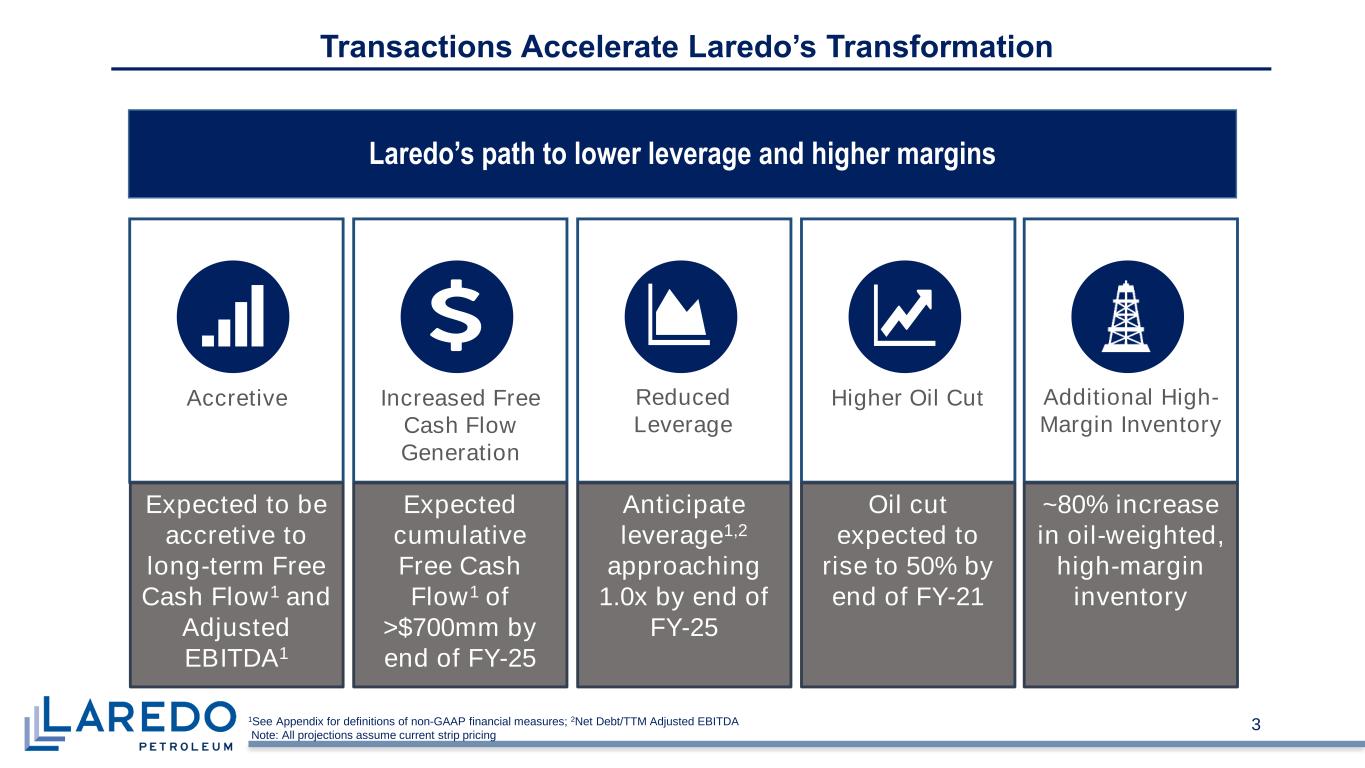
Transactions Accelerate Laredo’s Transformation Laredo’s path to lower leverage and higher margins 3 Accretive Expected to be accretive to long-term Free Cash Flow1 and Adjusted EBITDA1 Increased Free Cash Flow Generation Expected cumulative Free Cash Flow1 of >$700mm by end of FY-25 Reduced Leverage Anticipate leverage1,2 approaching 1.0x by end of FY-25 Higher Oil Cut Oil cut expected to rise to 50% by end of FY-21 Additional High- Margin Inventory ~80% increase in oil-weighted, high-margin inventory 1See Appendix for definitions of non-GAAP financial measures; 2Net Debt/TTM Adjusted EBITDA Note: All projections assume current strip pricing
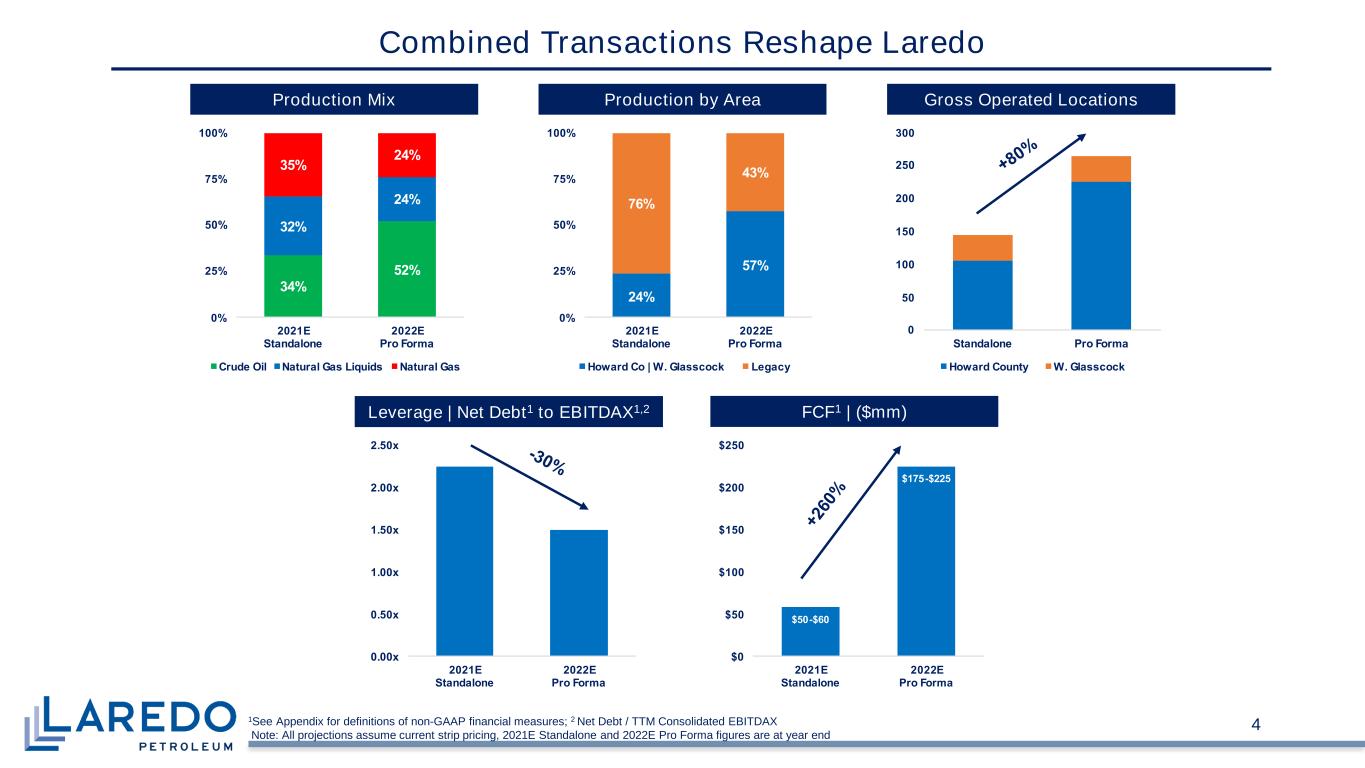
tandalone ro orma o ard o nt lasscoc tandalone ro orma tandalone ro orma tandalone ro orma o ard o lasscoc Le ac tandalone ro orma r de il at ral as Li ids at ral as 4 Combined Transactions Reshape Laredo Production Mix Production by Area Gross Operated Locations Leverage | Net Debt1 to EBITDAX1,2 FCF1 | ($mm) 1See Appendix for definitions of non-GAAP financial measures; 2 Net Debt / TTM Consolidated EBITDAX Note: All projections assume current strip pricing, 2021E Standalone and 2022E Pro Forma figures are at year end
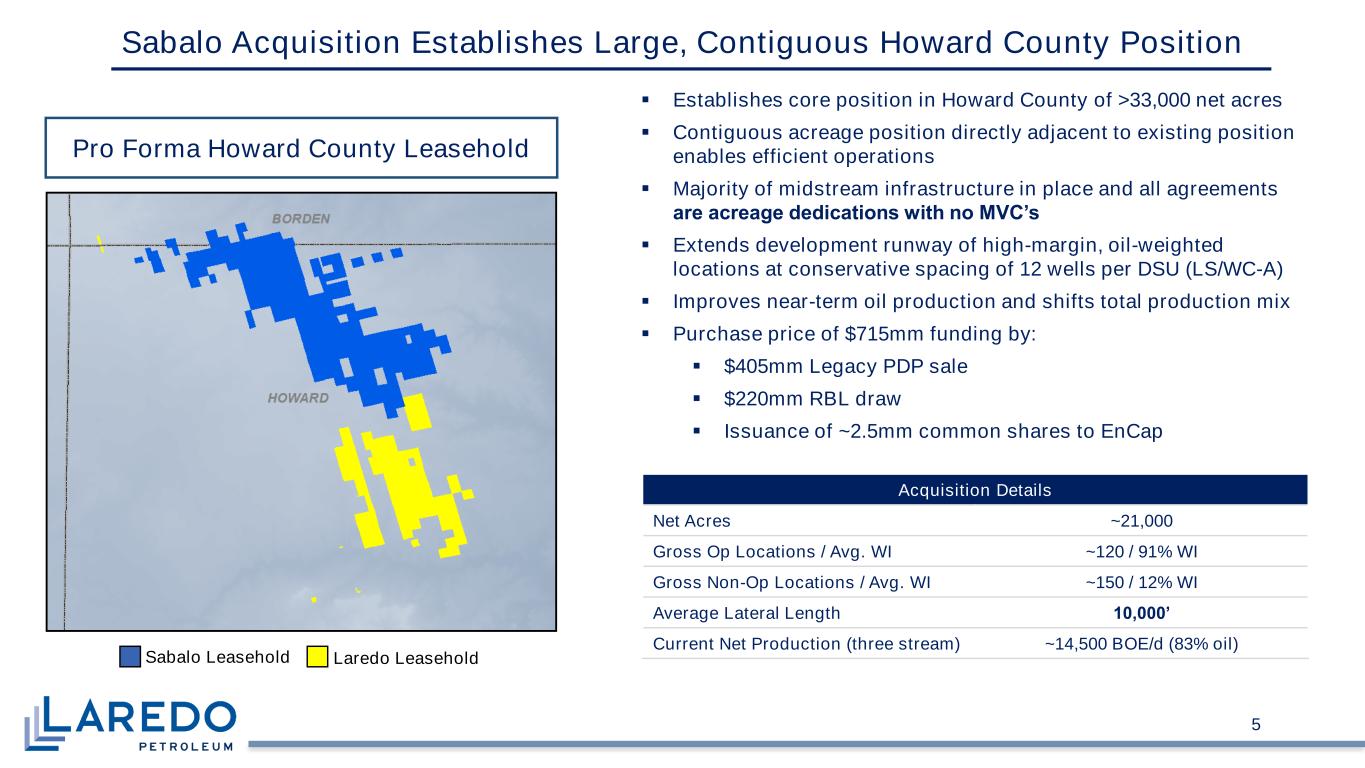
5 Sabalo Acquisition Establishes Large, Contiguous Howard County Position Sabalo Leasehold Laredo Leasehold Pro Forma Howard County Leasehold ▪ Establishes core position in Howard County of >33,000 net acres ▪ Contiguous acreage position directly adjacent to existing position enables efficient operations ▪ Majority of midstream infrastructure in place and all agreements are acrea e dedications ith no MV ’s ▪ Extends development runway of high-margin, oil-weighted locations at conservative spacing of 12 wells per DSU (LS/WC-A) ▪ Improves near-term oil production and shifts total production mix ▪ Purchase price of $715mm funding by: ▪ $405mm Legacy PDP sale ▪ $220mm RBL draw ▪ Issuance of ~2.5mm common shares to EnCap Acquisition Details Net Acres ~21,000 Gross Op Locations / Avg. WI ~120 / 91% WI Gross Non-Op Locations / Avg. WI ~150 / 12% WI Average Lateral Length , ’ Current Net Production (three stream) ~14,500 BOE/d (83% oil)
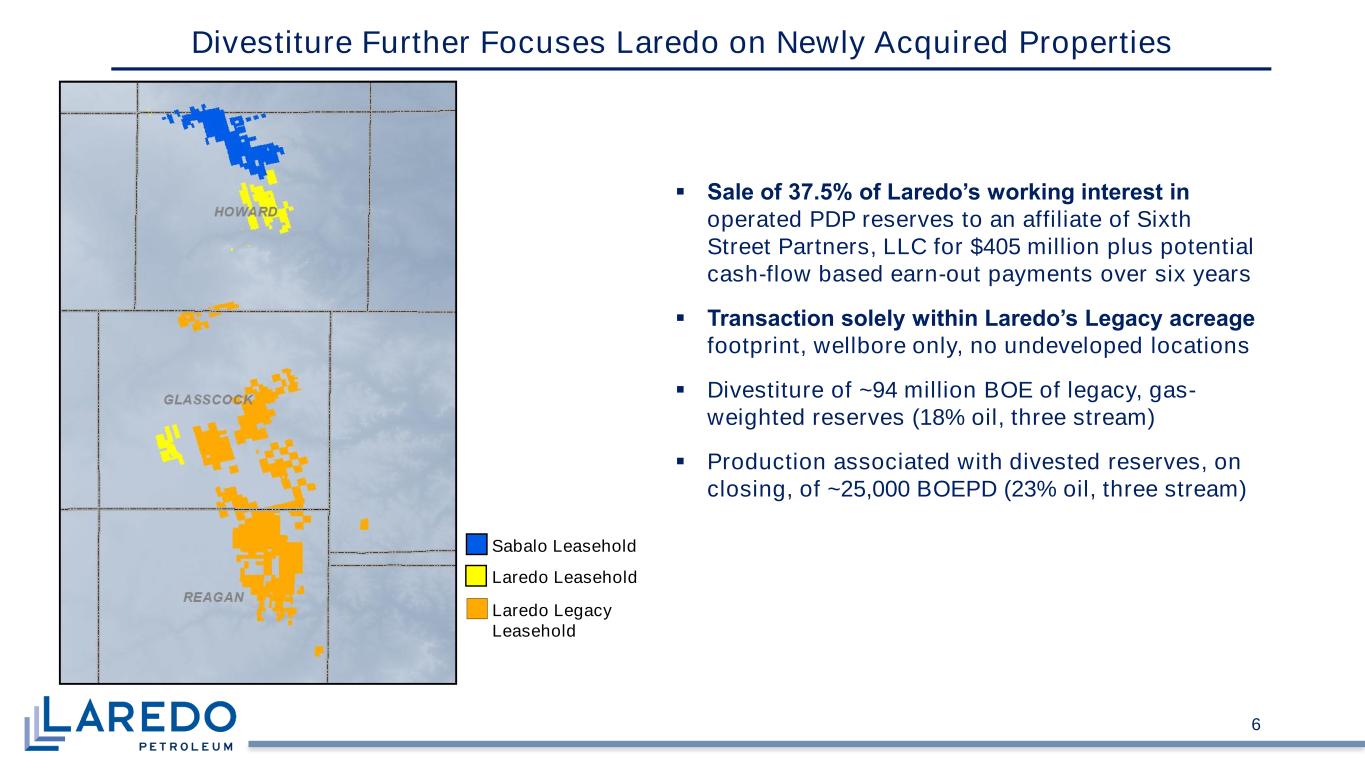
6 Divestiture Further Focuses Laredo on Newly Acquired Properties Sabalo Leasehold Laredo Leasehold Laredo Legacy Leasehold ▪ ale of of Laredo’s or in interest in operated PDP reserves to an affiliate of Sixth Street Partners, LLC for $405 million plus potential cash-flow based earn-out payments over six years ▪ Transaction solel ithin Laredo’s Le ac acrea e footprint, wellbore only, no undeveloped locations ▪ Divestiture of ~94 million BOE of legacy, gas- weighted reserves (18% oil, three stream) ▪ Production associated with divested reserves, on closing, of ~25,000 BOEPD (23% oil, three stream)
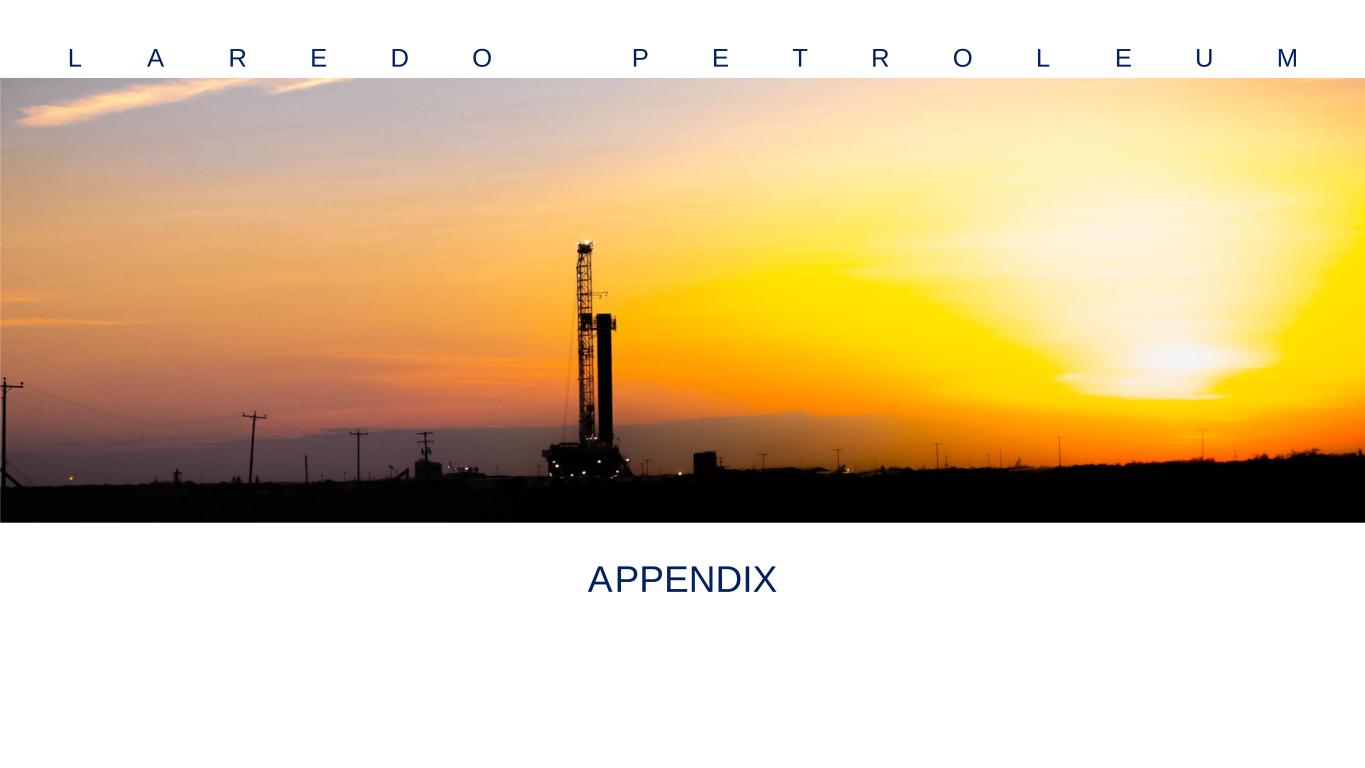
L A R E D O P E T R O L E U M APPENDIX
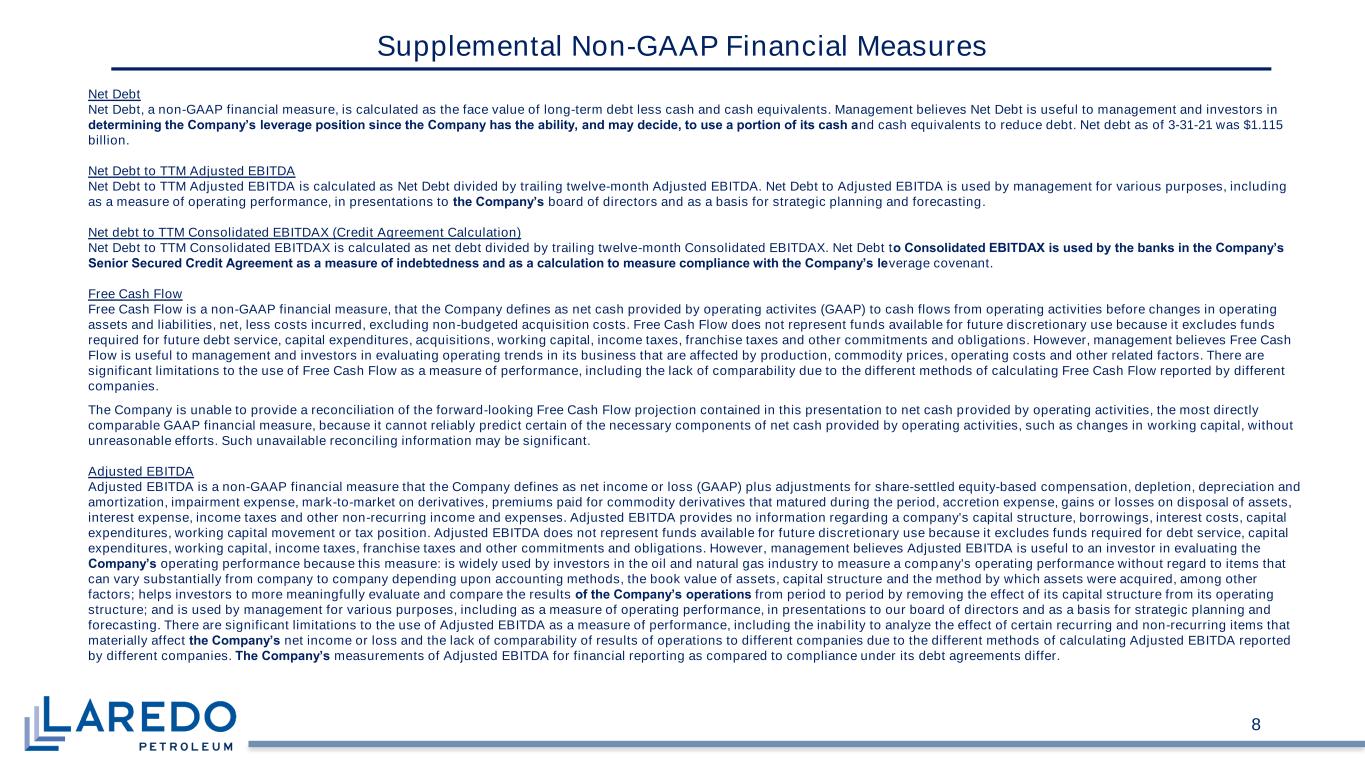
Net Debt Net Debt, a non-GAAP financial measure, is calculated as the face value of long-term debt less cash and cash equivalents. Management believes Net Debt is useful to management and investors in determinin the ompan ’s levera e position since the ompan has the abilit , and ma decide, to se a portion of its cash and cash equivalents to reduce debt. Net debt as of 3-31-21 was $1.115 billion. Net Debt to TTM Adjusted EBITDA Net Debt to TTM Adjusted EBITDA is calculated as Net Debt divided by trailing twelve-month Adjusted EBITDA. Net Debt to Adjusted EBITDA is used by management for various purposes, including as a measure of operating performance, in presentations to the ompan ’s board of directors and as a basis for strategic planning and forecasting. Net debt to TTM Consolidated EBITDAX (Credit Agreement Calculation) Net Debt to TTM Consolidated EBITDAX is calculated as net debt divided by trailing twelve-month Consolidated EBITDAX. Net Debt to onsolidated BITDAX is sed b the ban s in the ompan ’s enior ec red redit A reement as a meas re of indebtedness and as a calc lation to meas re compliance ith the ompan ’s leverage covenant. Free Cash Flow Free Cash Flow is a non-GAAP financial measure, that the Company defines as net cash provided by operating activites (GAAP) to cash flows from operating activities before changes in operating assets and liabilities, net, less costs incurred, excluding non-budgeted acquisition costs. Free Cash Flow does not represent funds available for future discretionary use because it excludes funds required for future debt service, capital expenditures, acquisitions, working capital, income taxes, franchise taxes and other commitments and obligations. However, management believes Free Cash Flow is useful to management and investors in evaluating operating trends in its business that are affected by production, commodity prices, operating costs and other related factors. There are significant limitations to the use of Free Cash Flow as a measure of performance, including the lack of comparability due to the different methods of calculating Free Cash Flow reported by different companies. The Company is unable to provide a reconciliation of the forward-looking Free Cash Flow projection contained in this presentation to net cash provided by operating activities, the most directly comparable GAAP financial measure, because it cannot reliably predict certain of the necessary components of net cash provided by operating activities, such as changes in working capital, without unreasonable efforts. Such unavailable reconciling information may be significant. Adjusted EBITDA Adjusted EBITDA is a non-GAAP financial measure that the Company defines as net income or loss (GAAP) plus adjustments for share-settled equity-based compensation, depletion, depreciation and amortization, impairment expense, mark-to-market on derivatives, premiums paid for commodity derivatives that matured during the period, accretion expense, gains or losses on disposal of assets, interest expense, income taxes and other non-recurring income and expenses. Adjusted EBITDA provides no information regarding a company's capital structure, borrowings, interest costs, capital expenditures, working capital movement or tax position. Adjusted EBITDA does not represent funds available for future discretionary use because it excludes funds required for debt service, capital expenditures, working capital, income taxes, franchise taxes and other commitments and obligations. However, management believes Adjusted EBITDA is useful to an investor in evaluating the ompan ’s operating performance because this measure: is widely used by investors in the oil and natural gas industry to measure a company's operating performance without regard to items that can vary substantially from company to company depending upon accounting methods, the book value of assets, capital structure and the method by which assets were acquired, among other factors; helps investors to more meaningfully evaluate and compare the results of the ompan ’s operations from period to period by removing the effect of its capital structure from its operating structure; and is used by management for various purposes, including as a measure of operating performance, in presentations to our board of directors and as a basis for strategic planning and forecasting. There are significant limitations to the use of Adjusted EBITDA as a measure of performance, including the inability to analyze the effect of certain recurring and non-recurring items that materially affect the ompan ’s net income or loss and the lack of comparability of results of operations to different companies due to the different methods of calculating Adjusted EBITDA reported by different companies. The ompan ’s measurements of Adjusted EBITDA for financial reporting as compared to compliance under its debt agreements differ. 8 Supplemental Non-GAAP Financial Measures
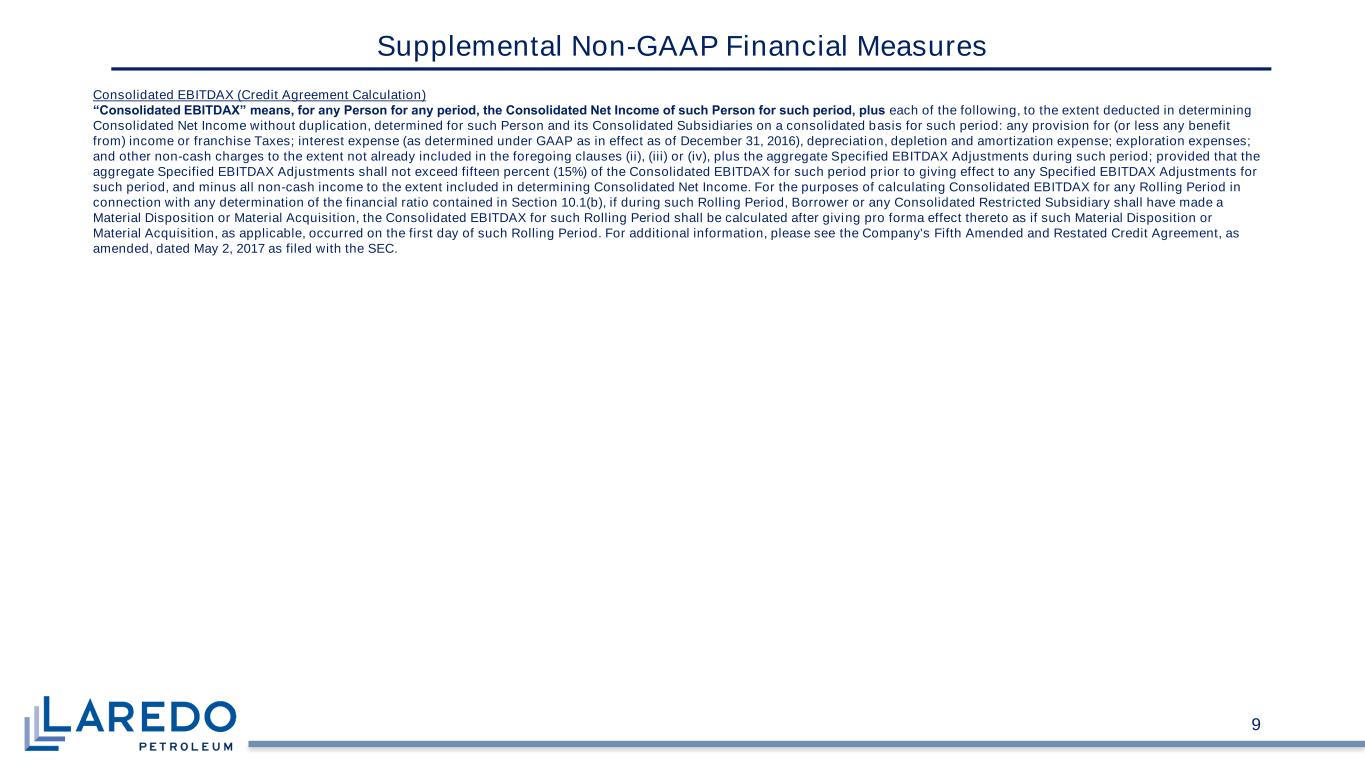
9 Supplemental Non-GAAP Financial Measures Consolidated EBITDAX (Credit Agreement Calculation) “ onsolidated BITDAX” means, for an erson for an period, the onsolidated et Income of s ch erson for s ch period, pl s each of the following, to the extent deducted in determining Consolidated Net Income without duplication, determined for such Person and its Consolidated Subsidiaries on a consolidated basis for such period: any provision for (or less any benefit from) income or franchise Taxes; interest expense (as determined under GAAP as in effect as of December 31, 2016), depreciation, depletion and amortization expense; exploration expenses; and other non-cash charges to the extent not already included in the foregoing clauses (ii), (iii) or (iv), plus the aggregate Specified EBITDAX Adjustments during such period; provided that the aggregate Specified EBITDAX Adjustments shall not exceed fifteen percent (15%) of the Consolidated EBITDAX for such period prior to giving effect to any Specified EBITDAX Adjustments for such period, and minus all non-cash income to the extent included in determining Consolidated Net Income. For the purposes of calculating Consolidated EBITDAX for any Rolling Period in connection with any determination of the financial ratio contained in Section 10.1(b), if during such Rolling Period, Borrower or any Consolidated Restricted Subsidiary shall have made a Material Disposition or Material Acquisition, the Consolidated EBITDAX for such Rolling Period shall be calculated after giving pro forma effect thereto as if such Material Disposition or Material Acquisition, as applicable, occurred on the first day of such Rolling Period. For additional information, please see the Company's Fifth Amended and Restated Credit Agreement, as amended, dated May 2, 2017 as filed with the SEC.
